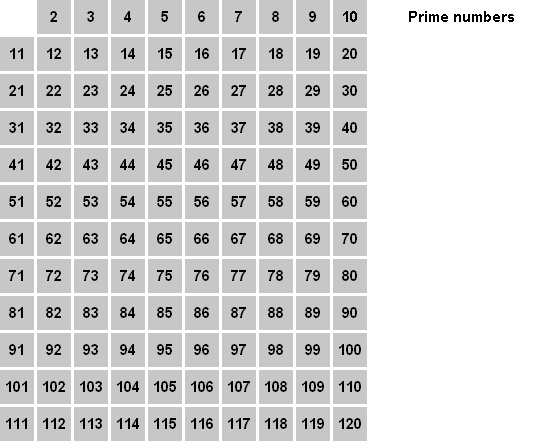| Currently there may be errors shown on top of a page, because of a missing Wiki update (PHP version and extension DPL3). |
| Topics | Help • Register • News • History • How to • Sequences statistics • Template prototypes |
Sieve of Eratosthenes
The sieve of Eratosthenes is a method to find all prime numbers smaller than a given integer
It is based on the following observation:
- Let
Algorithm
It is computed as follows; an example is given with
- First, list out all the integers
- 01 02 03 04 05 06 07 08 09 10
- 11 12 13 14 15 16 17 18 19 20
- 21 22 23 24 25 26 27 28 29 30
- 31 32 33 34 35 36 37 38 39 40
- 41 42 43 44 45 46 47 48 49 50
- 51 52 53 54 55 56 57 58 59 60
- 61 62 63 64 65 66 67 68 69 70
- 71 72 73 74 75 76 77 78 79 80
- 81 82 83 84 85 86 87 88 89 90
- 91 92 93 94 95 96 97 98 99 100
- Let the smallest prime be
- 01 02 03
04050607080910 - 11
121314151617181920 - 21
222324252627282930 - 31
323334353637383940 - 41
424344454647484950 - 51
525354555657585960 - 61
626364656667686970 - 71
727374757677787980 - 81
828384858687888990 - 91
9293949596979899100
- Now we look for the smallest number larger than
- 01 02 03
04050607080910 - 11
121314151617181920 21222324252627282930- 31
323334353637383940 - 41
424344454647484950 51525354555657585960- 61
626364656667686970 - 71
727374757677787980 81828384858687888990- 91
9293949596979899100
- The next number not crossed out is
- In general, for any
Complexity
There are approximately
The sieve of Eratosthenes has also been adapted to form many faster sieves, like the Atkin Sieve.
The sieve of Eratosthenes is generally used to generate a list of primes for computation of some sort. For example, one may use it to rapidly generate a list of possible Mersenne number exponents to test for primality.
